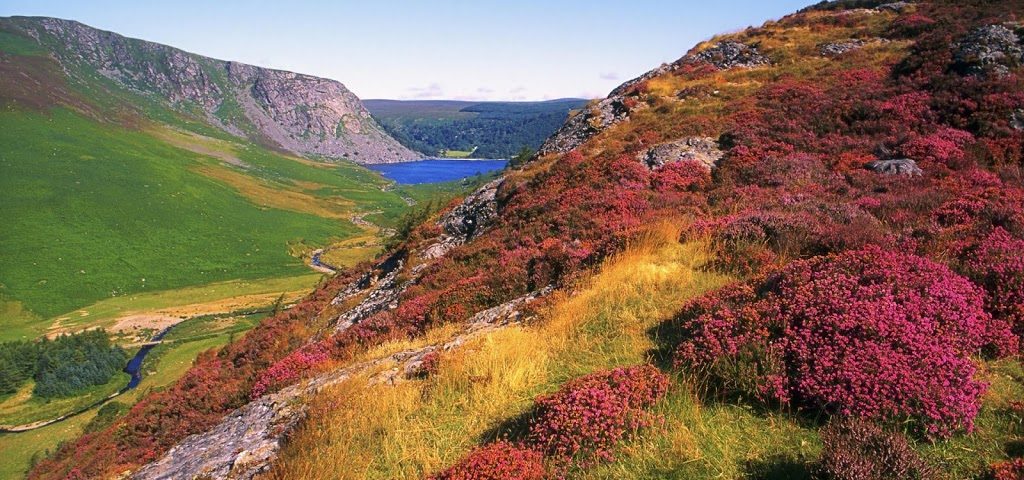Vegetation Management – Hill farmers, the under-valued custodians of hill ecosystems

There was much interest and discussion as a result of this oral presentation by Brian Dunne at the 2017 ENVIRON conference (10th-12th April) in Athlone. The ENVIRON conference is the largest gathering of environmental researchers in Ireland with over 300 researchers in attendance this year.
Brian began with a short description of what is meant by traditional uplands management in Wicklow. A mosaic of low heather, rarely taller than 60 cm (2 feet), was maintained by grazing and burning and provided safe ground nest sites with cover from predatory birds. Only unpalatable taller, leggier woody heather was burnt as it was not grazed. This low intensity burning left the rootstock and peat layer undisturbed. Between the stands of heather a host of other plants flourished, providing optimal conditions for grazing and biodiversity. Records for the Powerscourt estate show a record 358 grouse were shot in 1890 on Sheeps Bank, indicating the quality of the habitat at that time.
So what happened? The unintended consequences of the events of the last century such as World Wars and EU membership, new designations & changes in legislation, the formation of the Wicklow National Park and the development of forestry in the uplands all played a role in changing the socioeconomics of upland areas and changes to upland farming. There has been an ongoing decline in upland sheep farmers who acted as the custodians of upland habitats for generations. The decline in young farmers is of particular concern. Recent research has found that this decline in upland farming to be primarily due to poor profitability. At one time the annual crop of wool meant sheep were double earners both as providers of wool and meat. The price of wool is now at an all-time low, with changes in trends and the development of a disposable society with a penchant for synthetic fibres.
Upland farmers are also finding it more difficult to effectively manage their lands due to restrictive legislation. Much of the deterioration in the quality of upland habitats has been attributed to the alteration of the vegetation management season. Traditionally it was permitted to burn or remove vegetation up to April 15th each year, but is now illegal after March 1st (amended Section 40 of the Wildlife Act, 2000). This date restriction is in the Republic of Ireland only anddiffers from the UK who can effectively manage vegetation to April 15theach year. In the UK, the RSPB currently recommend such rotational patch burning of heather to provide attractive nesting sites and also state that moorland managed for red grouse support higher densities of curlews. The current season in Ireland is largely unworkable due to unsuitable weather conditions so early in the year. A result of this has been an increased risk of wildfire from a build-up of overgrown woodier vegetation. Curiously, there are few newspaper reports of devastating wildfires before 2000.
The destructive effects of wildfires and the ecological damage lead to lively debate. Wildfires can lead to the destruction of an entire hillside, with burning of the peat layer to the subsoil. Without the vegetation cover, erosion takes place resulting in increased turbidity of the runoff water. This is an increased cost for Irish Water as the Wicklow uplands are the main catchment areas for Dublin’s water supply. In addition the capacity of peat, and sphagnum moss, to store and hold water is gone so less protection against floods. Following a wildfire, recolonisation of thevegetation takes years as the soil microbiome is gone; heather regeneration is particularly slow while bracken is a very invasive. The spread of bracken pose more issues including being toxic to livestock and harbouring ticks. Tickborne diseases, such as Lyme disease and other co-infections affect sheep, deer and humans and are recognised as a public health issue for all users of the uplands. Carbon sequestration and mitigation were also discussed. The Wicklow Uplands, with good vegetation management and increased peaty soil depth, could provide a good carbon store. This sequestration would help meet the national requirements to reduce carbon emissions. Though a wildfire would instantly negate any mitigation as the store literally goes up in smoke.
Thus, up till now hill farmers have been underappreciated, but the custodians of the hills. Tweeted at the meeting- ‘hill farmers endangered species’! Should they also be on the Red List? Young farmers have to be encouraged back to the hills. This will require mentoring them in herding skills and also developing flocks of sheep that know the hills. Hefted sheep and young farmers take time to develop.
Claire Chambers, WUC Board Member


